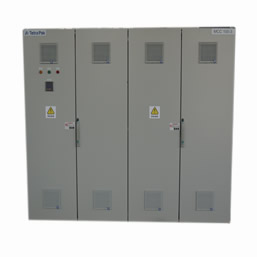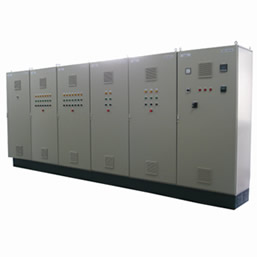Development and Application of Power Electronic Devices and
Article provenance
:Online Time:2019-07-17 15:45
Introduction
With the rapid development of power electronics and computer technology, AC speed regulation has become the trend of development instead of DC speed regulation. Frequency conversion speed regulation is recognized as the most promising speed regulation mode at home and abroad for its excellent speed regulation, start-up and brake performance. Frequency conversion technology is the core technology of AC speed regulation, power electronics and computer technology are the core of frequency conversion technology, and power electronic devices are the basis of power electronics technology. Power electronics technology is a new and high technology which has been developed rapidly in recent years. It is widely used in the fields of mechatronics, motor drive, aerospace and so on. It has become a new and high technology developed by all countries. Experts predict that computer technology and power electronics technology are the two most important technologies in the highly developed field of automatic control in the 21st century.
I. Development of Power Electronic Devices
The appearance of thyristors in the United States in the late 1950s marked the birth of power electronics technology. The first generation of power electronic devices are mainly silicon controlled rectifier (SCR), which was listed as energy-saving technology in China in the 1970s. However, SCR is a semi-controlled switching device which can only control its turn-on but not turn-off. It is limited in the application of AC drive and variable frequency power supply. The power transistor (GTR), gate-switchable thyristor (GTO), power MOSFET, insulated gate transistor (IGBT), electrostatic induction transistor (SIT) and electrostatic induction thyristor (SITH) invented successively after the 1970s have the common characteristics of not only controlling its turn-on, but also controlling its turn-off. They are all controlled switches. Because no commutation circuit is needed, the volume and weight of the device are much lower than that of SCR. At present, IGBT has become the mainstream device with its excellent characteristics, and GTO with large capacity also has a certain position.
Many countries are making great efforts to develop high-capacity devices, and 6000V IGBT has been produced abroad. IEGT (injection enhanced gate thyristor) is a new device which combines the advantages of IGBT and GTO. 1000A/4500V samples have been published. IGCT (integrated gate eommutated thyristor) uses buffer layer and transparent emitter on the basis of GTO. It is equivalent to thyristor when turned on and transistor when turned off, thus effectively coordinating the contradiction between on-state voltage and blocking voltage. Its working frequency can reach several thousand Hertz [2] [3]. ABB Switzerland has launched IGCT up to 4500-6000V, 3000-3500A. The development of IGCT makes MCT play an important role in the new pattern of power electronic devices. Compared with developed countries, China has a bigger gap in device manufacturing than in application. New power devices such as IGBT module, IEGT, MOS gated thyristor, high voltage arsenic crop high frequency rectifier diode, silicon carbide (SIC) and so on have been developed in foreign countries. It can be believed that the main trend of power electronic devices in the 21st century will be to use GaAs, SiC and other new semiconductor materials to achieve the success rate devices and realize people's pursuit of "ideal devices".
High reliability power electronics building blocks (PEBB) and integrated power electronics modules (IPEM) are new hotspots in the recent development of power electronics technology in the United States. The fierce competition between GTO and IGCT, IGCT and high voltage IGBT will bring more opportunities and challenges for the development of new power electronics and frequency conversion technologies in the 21st century.
II. The Development of Frequency Conversion Technology
Frequency conversion technology was born in response to the need of stepless speed regulation of AC motor. Updating Power Electronic Devices Promotes Power Conversion
The continuous development of technology. Initially, the technology of frequency conversion was limited to frequency conversion but not voltage conversion. Since the 1970s, the research of PWM-VVVVF speed regulation has attracted great attention. In the 1980s, as the core of frequency conversion technology, the optimization of PWM mode attracted people's great interest, and many optimization modes were obtained, such as longitudinal division of modulation wave, phase-shifted carrier PWM technology, phase-shifted carrier PWM technology, carrier-modulated wave synchronous phase-shifted PWM technology and so on.
VVVF frequency converter has been widely used in various fields of industry because of its relatively simple control and good mechanical hardness, which can meet the requirements of smooth speed regulation of general transmission. However, at low frequencies, the output voltage of this control method is small, and the influence of the stator resistance voltage drop is significant, so the maximum output torque decreases.
The method of vector control variable frequency speed regulation is that the stator AC currents Ia, Ib and Ic of asynchronous motor in three-phase coordinate system are transformed into DC currents Iml and Itl in synchronous rotating coordinate system through three-phase-two-phase transformation, and then the control quantity of DC motor is obtained by imitating the control method of DC motor, and the corresponding coordinates are obtained. Inverse transformation is used to control the asynchronous motor.
Direct Torque Control (DTC) directly analyses the mathematical model of AC motor in the stator coordinate system, and controls the flux and torque of the motor. It does not need to convert AC motors into equivalent DC motors, thus eliminating many complex calculations in vector rotation transformation; it does not need to imitate the control of DC motors, nor does it need to simplify the mathematical model of AC motors for decoupling.
VVVF frequency conversion, vector control frequency conversion and direct torque control frequency conversion are all one of AC-DC-AC frequency conversion. The common shortcomings are low input power factor, high harmonic current, large storage capacitance for DC circuit, and no feedback of regenerated energy back to the grid, that is, no four quadrant operation. For this reason, matrix AC-AC frequency conversion came into being.
3. Frequency Conversion Technology




